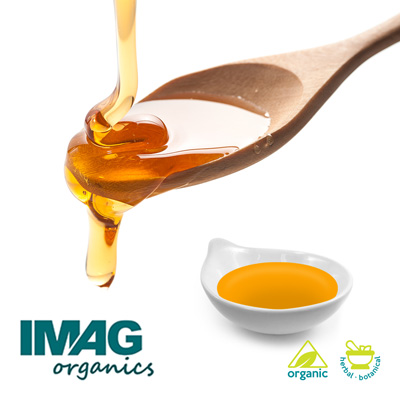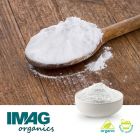
Organic 100% Blue Agave Syrup by IMAG Organics
As a member of Ingredients Online, you can download QC documents, see detailed product information, request samples, sell your own products, chat with experts, and more!

 Add to Wishlist
Add to Wishlist
| Quantity | Price | Save |
|---|


Where does Agave Nectar come from?
Agaves come in many sizes and colors — well over 100 species. Due to the Blue Agave’s high carbohydrate content (which results in a high percentage of fructose in the final nectar), Blue Agave is the preferred species for producing nectar.Though there are other species used to produce agave nectars, such as the Maguey Agave, the premium nectars are produced from 100% Weber Blue Agave.
All of IMAG products are made from hand-harvested certified organic premium 100% Weber Blue Agave and is organically grown and sustainably farmed and contains no chemicals, enzymes, or additives.
Agave Nectar vs. Artificial Sweeteners:
It can be a challenge for even experienced cooks to substitute artificial sweeteners for sugars without compromising food quality or palatability. An artificial sweetener may be suitable for reducing the caloric content and glycemic index of a dish, but they lose their usefulness in many other culinary applications where a sugar is needed for more than its ability to sweeten.In many regards, agave nectar bridges the gap between real and artificial sweeteners. While it has all the useful properties of real sugars, its lower glycemic index helps protect against health risks associated with higher glycemic sweeteners. Agave nectar can be used in many more applications than artificial sweeteners, while also producing more palatable results. Since it is composed of real sugars (fructose and glucose), agave nectar performs admirably in the kitchen and bakery. It matches refined sugars in all the qualities mentioned above, serving as a browning agent, a humectant, a softener, and a preservative.
How is Agave Nectar made?
When the agave has grown to 7-10 years old, the leaves of the plant are cut off, revealing the core of the plant (called the “pina”). When harvested, the pina resembles a giant pineapple and can weigh in at 50 to 150 pounds.To make the agave nectar, sap is extracted from the pina, filtered, and heated at a low temperature, which breaks down the carbohydrates into sugars. Lighter and darker varieties of agave nectar are made from the same plants. Because of the low temperatures used in processing many varieties (under 118°F) raw foods enthusiasts generally regard agave nectar as a raw food.Click here to continue learning about Agave Syrup
Browse a Variety of Recipes Using Agave Syrup
Gluten Free Nutty Granola
- 3 cups gluten free rolled oats
- 1/4 cup coconut oil
- 1/2 cup IMAG Organic Agave Syrup 100 gr crunchy peanut butter
- 1⁄2 cup pecan nuts
- 1 tsp ground cinnamon
- 1 tsp vanilla extract
- 1/2 cup chia seeds
- 1/4 tsp salt
Vegan Coconut Cake
- 190 g grated coconut
- 300 gr coconut milk yoghurt
- 120 g coconut oil
- 3 tbsp IMAG Organic Agave Syrup 30 g coconut flour
- Grated lime zest
- 1 pinch of salt
Green Super Smoothie
- 1 avocado
- 1/2 mango
- 200 gr spinach
- 100 gr kale
- 2 tbsp IMAG Organic Agave Syrup 1⁄2 cup cold coconut milk
Fructan Metabolism in A. tequilana Weber Blue Variety along Its Developmental Cycle in the Field
Abstract: Fructan, as reserve carbohydrate, supplies energy needs during vegetative development, thereby exhibiting variations in its content and composition. Fructan metabolism in Agave tequilana Blue variety from 2- to 7-year-old plants was analyzed in this work. Soluble carbohydrates were determined at all ages. Fructan (328−711 mg/g), sucrose (14−39 mg/g), fructose (11−20 mg/g), glucose (4−14 mg/g), and starch (0.58−4.98 mg/g) were the most abundant carbohydrates. Thin-layer chromatography exhibited that 2−5-year-old plants mainly stored fructooligosaccharides, while 6−7-year-old plants mainly contained long-chain fructans. The fructan degree of polymerization (DP) increased from 6 to 23 throughout plant development. The 7-year-old plants mainly stored highly branched agavins. Partially methylated alditol acetate analyzed by gas chromatography−mass spectrometry reveals that fructan molecular structures became more complex with plant age. For the first time, we report the presence of a large number of DP3 (seven forms), DP4 (eight forms), and DP5 (six forms) isomers for agave fructans. Overall, fructan metabolism in A. tequilana displays changes in its soluble carbohydrates, DP, type, and fructan structures stored, along its developmental cycle in the field.
Click here to read the full study
Product Overview
IMAG Agave Syrup is a natural sweetener which is made by the controlled hydrolysis of the core of the Blue Weber Agave variety and has a wide range of applications. Due to its low glycemic index of 17.1 it is an ideal substitute for sugar and honey.
IMAG Agave Syrup is pure and does not contain sugars from any other plant or source. IMAG is one of the largest global agave manufacturers which brings scale and efficiency.
General Details
Product Highlights
- Starting Materials: Agave Tequilana Weber blue variety
- Plant Part Used: Agave Pina
- Processing Method: Extraction, Filtration, Hydrolysis, Evaporation, Homogenization
- Botanical Name: Agave Tequilana
Properties
*NOTE: These statements have not been evaluated by the Food and Drug Administration. This product is not intended to diagnose, treat, cure or prevent any disease.
*All product pictures are for display purposes only, it may not reflect the exact product color or mesh size, please refer to spec sheet for details.






